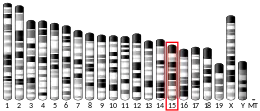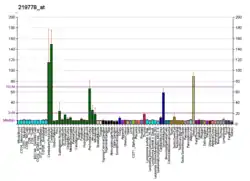ZFPM2
Zinc finger protein ZFPM2, i.e. zinc finger protein, FOG family member 2, but also termed Friend of GATA2, Friend of GATA-2, FOG2, or FOG-2, is a protein that in humans is encoded by the ZFPM2 and in mice by the Zfpm2 gene.[5][6][7]
The zinc finger-containing protein encoded by this gene is a widely expressed member of the FOG family of regulators of transcription factors. The family consists of the ZFPM1 and ZFPM2 genes in humans and Zfpm1 and Zfpm2 genes in mice. Its members may act as coactivators and/or corepressors to modulate the activity of GATA transcription factors. That is, the ZFPM2 protein appears able to interact directly with and thereby either enhance or repress the ability of GATA transcription factors to stimulate the expression of their target genes; the direction of ZFPM2's actions depends on the contexts of the promoter sections of the various GATA target genes.[7]
The ZFPM2 protein interacts primarily with the GATA4 but also with GATA2, GATA5, and GATA6 transcription factors. ZFPM2 protein's interaction with GATA4 is notable for controlling the embryonic development of various tissues, particularly the heart, diaphragm, and gonads. Correspondingly, ZFPM2 mutations are responsible for certain forms of congenital heart defects, congenital diaphragmatic hernias,[8] and ambiguous genitalia[9] in mice as well as humans.
Gene
The ZFPM2 gene is found in a wide range of animal species from flies to humans. The human gene is located on the long or "q" arm of chromosome 8 at position 23.1 (i.e. 8q23.1) and consists of 9 exons.[10] The equivalent mouse gene, Zfpm2, is located on chromosome 15 and consists of 8 exons.[11] Knockout of ZFPM2 is embryonic lethal in mice, with mice dying at embryonic day 12.5-15.5 due to congenital cardiac defects (thin heart ventricular muscle, common atrioventricular canal, and the tetralogy of Fallot malformation.[12] ZFPM2 expression in mice is also required for normal development of the gonads, lung and diaphragm.[13]
Protein
Both the human and mouse ZFPM2 proteins consists of 1151 amino acids and are expressed in various tissues. The human protein is expressed at relatively high levels in the adult ovary and uterine endometrium while the mouse protein is expressed at relatively high levels in the central nervous system cerebellum and, during the early stages of its development, the heart. Human ZFPM2 contains 8 zinc finger structural motifs and interacts directly with various members of the GATA transcription factor family to modify their ability to stimulate the expression of their target genes. For example, it has been shown to bind directly with the N-terminal zinc finger of the GATA4 transcription factor to inhibit its ability to stimulate the expression of a target gene in an in vitro model system.[13][14][11][10]
The extreme N terminal end of the ZFPM2 protein contains two domains, one of which interacts directly with the Mi-2/NuRD complex (i.e. nucleosome remodeling and histone deacetylase complex or NuRD complex) and other of which binds CTBP1 or CTBP2 proteins. The NuRD complex and the CtBPs are classified as corepressors. that act to promote the ability of ZFPM2 to inhibit the ability of GATA proteins to stimulate the expression of their target genes.[13]
Pathophysiology
ZFPM2 regulates the expression of certain GATA target genes by up-regulating or down-regulating the ability of the GATA transcription factors, primarily GATA3, GATA4, GATA5, and GATA6, to stimulate the expression of their target genes. Interactions with the NuRD complex or a CTBP can cause ZFPM2 to inhibit the ability of GATA3-6 proteins to stimulate the expression of their target genes.[13]
Clinical relevancy
Congenital heart disease
Mutations in the ZFPM2 gene are responsible for rare and sporadic cases of congenital heart disease. These include cases of Tetralogy of Fallot, truncus arteriosus, failure to from the pulmonary artery valve combined with ventricular septal defect, double outlet right ventricle, transposition of the great arteries, and interrupted aortic arch.[14] Sporadic cases of Tetralogy of Fallot were also found in cases where the levels of Hypermethylation at CpG sites in the ZFPM2 gene promoter were greatly elevated; these cases were associated with decreases cardiac tissue levels of mRNA for ZFPM2.[15] These cases likely reflect the role of ZFPM2 in promoting GATA4's function in the embryonic development of the heart.[12][13]
Congenital diaphragmatic hernia
ZFPM2 heterozygous gene mutations are responsible for sporadic cases of congenital diaphragmatic hernias. This development disorder may be the underlying cause for the development of congenital lung dysplasia and pulmonary vascular disorder that leads to pulmonary hypertension. These defects are considered due to haploinsufficiency in ZFPM2 protein and consequential failure of GATA4 to promote normal lung development.[8][16]
Sex development
Heterozygous mutations in the ZFPM2 gene are responsible for sporadic, very rare cases of a familial form of disorders of sex development, ambiguous genitalia. The disorder likely reflects haploinsufficiency of the ZFPM2 protein and consequential reduced regulation of GATA4 in promoting normal development of the gonads.[9]
References
- GRCh38: Ensembl release 89: ENSG00000169946 - Ensembl, May 2017
- GRCm38: Ensembl release 89: ENSMUSG00000022306 - Ensembl, May 2017
- "Human PubMed Reference:". National Center for Biotechnology Information, U.S. National Library of Medicine.
- "Mouse PubMed Reference:". National Center for Biotechnology Information, U.S. National Library of Medicine.
- Svensson EC, Tufts RL, Polk CE, Leiden JM (March 1999). "Molecular cloning of FOG-2: a modulator of transcription factor GATA-4 in cardiomyocytes". Proc Natl Acad Sci U S A. 96 (3): 956–61. doi:10.1073/pnas.96.3.956. PMC 15332. PMID 9927675.
- Holmes M, Turner J, Fox A, Chisholm O, Crossley M, Chong B (September 1999). "hFOG-2, a novel zinc finger protein, binds the co-repressor mCtBP2 and modulates GATA-mediated activation". J Biol Chem. 274 (33): 23491–8. doi:10.1074/jbc.274.33.23491. PMID 10438528.
- "Entrez Gene: ZFPM2 zinc finger protein, multitype 2".
- Brady PD, Van Houdt J, Callewaert B, Deprest J, Devriendt K, Vermeesch JR (2014). "Exome sequencing identifies ZFPM2 as a cause of familial isolated congenital diaphragmatic hernia and possibly cardiovascular malformations". European Journal of Medical Genetics. 57 (6): 247–52. doi:10.1016/j.ejmg.2014.04.006. PMID 24769157.
- Brauner R, Picard-Dieval F, Lottmann H, Rouget S, Bignon-Topalovic J, Bashamboo A, McElreavey K (November 2016). "Familial forms of disorders of sex development may be common if infertility is considered a comorbidity". BMC Pediatrics. 16 (1): 195. doi:10.1186/s12887-016-0737-0. PMC 5129225. PMID 27899089.
- https://www.ncbi.nlm.nih.gov/gene/23414
- https://www.ncbi.nlm.nih.gov/gene/22762
- Cantor AB, Orkin SH (February 2005). "Coregulation of GATA factors by the Friend of GATA (FOG) family of multitype zinc finger proteins". Seminars in Cell & Developmental Biology. 16 (1): 117–28. doi:10.1016/j.semcdb.2004.10.006. PMID 15659346.
- Chlon TM, Crispino JD (November 2012). "Combinatorial regulation of tissue specification by GATA and FOG factors". Development. 139 (21): 3905–16. doi:10.1242/dev.080440. PMC 3472596. PMID 23048181.
- Pu T, Liu Y, Xu R, Li F, Chen S, Sun K (February 2018). "Identification of ZFPM2 mutations in sporadic conotruncal heart defect patients". Molecular Genetics and Genomics : MGG. 293 (1): 217–223. doi:10.1007/s00438-017-1373-6. PMID 29018978. S2CID 23888323.
- Sheng W, Chen L, Wang H, Ma X, Ma D, Huang G (July 2016). "CpG island shore methylation of ZFPM2 is identified in tetralogy of fallot samples". Pediatric Research. 80 (1): 151–8. doi:10.1038/pr.2016.42. PMID 26959486.
- Kardon G, Ackerman KG, McCulley DJ, Shen Y, Wynn J, Shang L, Bogenschutz E, Sun X, Chung WK (August 2017). "Congenital diaphragmatic hernias: from genes to mechanisms to therapies". Disease Models & Mechanisms. 10 (8): 955–970. doi:10.1242/dmm.028365. PMC 5560060. PMID 28768736.
Further reading
- Fox AH, Liew C, Holmes M, et al. (1999). "Transcriptional cofactors of the FOG family interact with GATA proteins by means of multiple zinc fingers". EMBO J. 18 (10): 2812–22. doi:10.1093/emboj/18.10.2812. PMC 1171362. PMID 10329627.
- Crispino JD, Lodish MB, Thurberg BL, et al. (2001). "Proper coronary vascular development and heart morphogenesis depend on interaction of GATA-4 with FOG cofactors". Genes Dev. 15 (7): 839–44. doi:10.1101/gad.875201. PMC 312667. PMID 11297508.
- Strausberg RL, Feingold EA, Grouse LH, et al. (2003). "Generation and initial analysis of more than 15,000 full-length human and mouse cDNA sequences". Proc. Natl. Acad. Sci. U.S.A. 99 (26): 16899–903. doi:10.1073/pnas.242603899. PMC 139241. PMID 12477932.
- Anttonen M, Ketola I, Parviainen H, et al. (2004). "FOG-2 and GATA-4 Are coexpressed in the mouse ovary and can modulate mullerian-inhibiting substance expression". Biol. Reprod. 68 (4): 1333–40. doi:10.1095/biolreprod.102.008599. PMID 12606418.
- Pizzuti A, Sarkozy A, Newton AL, et al. (2004). "Mutations of ZFPM2/FOG2 gene in sporadic cases of tetralogy of Fallot". Hum. Mutat. 22 (5): 372–7. doi:10.1002/humu.10261. PMID 14517948. S2CID 21531781.
- Hirai M, Ono K, Morimoto T, et al. (2004). "FOG-2 competes with GATA-4 for transcriptional coactivator p300 and represses hypertrophic responses in cardiac myocytes". J. Biol. Chem. 279 (36): 37640–50. doi:10.1074/jbc.M401737200. PMID 15220332.
- Gerhard DS, Wagner L, Feingold EA, et al. (2004). "The status, quality, and expansion of the NIH full-length cDNA project: the Mammalian Gene Collection (MGC)". Genome Res. 14 (10B): 2121–7. doi:10.1101/gr.2596504. PMC 528928. PMID 15489334.
- Chan EM, Comer EM, Brown FC, et al. (2005). "AML1-FOG2 fusion protein in myelodysplasia". Blood. 105 (11): 4523–6. doi:10.1182/blood-2004-07-2762. PMID 15705784.
- Ackerman KG, Herron BJ, Vargas SO, et al. (2005). "Fog2 is required for normal diaphragm and lung development in mice and humans". PLOS Genet. 1 (1): 58–65. doi:10.1371/journal.pgen.0010010. PMC 1183529. PMID 16103912.

- Lim J, Hao T, Shaw C, et al. (2006). "A protein-protein interaction network for human inherited ataxias and disorders of Purkinje cell degeneration". Cell. 125 (4): 801–14. doi:10.1016/j.cell.2006.03.032. PMID 16713569. S2CID 13709685.
- Finelli P, Pincelli AI, Russo S, et al. (2007). "Disruption of friend of GATA 2 gene (FOG-2) by a de novo t(8;10) chromosomal translocation is associated with heart defects and gonadal dysgenesis". Clin. Genet. 71 (3): 195–204. doi:10.1111/j.1399-0004.2007.00752.x. PMID 17309641. S2CID 20572160.
- Bleyl SB, Moshrefi A, Shaw GM, et al. (2007). "Candidate genes for congenital diaphragmatic hernia from animal models: sequencing of FOG2 and PDGFRalpha reveals rare variants in diaphragmatic hernia patients". Eur. J. Hum. Genet. 15 (9): 950–8. doi:10.1038/sj.ejhg.5201872. PMID 17568391.





